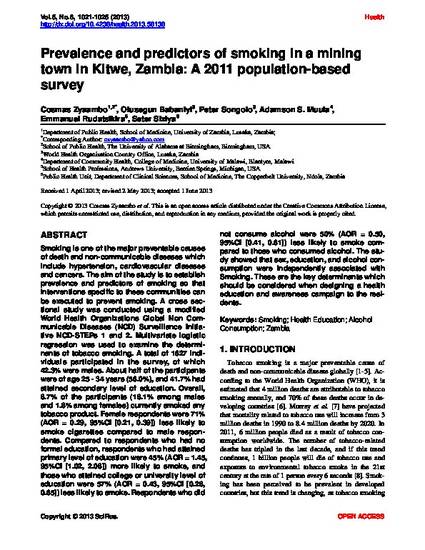
- Smoking,
- Health Education,
- Alcohol Consumption,
- Zambia
Smoking is one of the major preventable causes of death and non-communicable diseases which include hypertension, cardiovascular diseases and cancers. The aim of the study is to establish prevalence and predictors of smoking so that interventions specific to these communities can be executed to prevent smoking. A cross sectional study was conducted using a modified World Health Organizations Global Non Communicable Diseases (NCD) Surveillance Initiative NCD-STEPs 1 and 2. Multivariate logistic regression was used to examine the determinants of tobacco smoking. A total of 1627 individuals participated in the survey, of which 42.3% were males. About half of the participants were of age 25-34 years (56.0%), and 41.7% had attained secondary level of education. Overall, 8.7% of the participants (18.1% among males and 1.8% among females) currently smoked any tobacco product. Female respondents were 71% (AOR = 0.29, 95%CI [0.21, 0.39]) less likely to smoke cigarettes compared to male respondents. Compared to respondents who had no formal education, respondents who had attained primary level of education were 45% (AOR = 1.45, 95%CI [1.02, 2.08]) more likely to smoke, and those who attained college or university level of education were 57% (AOR = 0.43, 95%CI [0.28, 0.65]) less likely to smoke. Respondents who did not consume alcohol were 50% (AOR = 0.50, 95%CI [0.41, 0.61]) less likely to smoke compared to those who consumed alcohol. The study showed that sex, education, and alcohol consumption were independently associated with Smoking. These are the key determinants which should be considered when designing a health education and awareness campaign to the residents.
Available at: http://works.bepress.com/emmanuel_rudatsikira/38/
